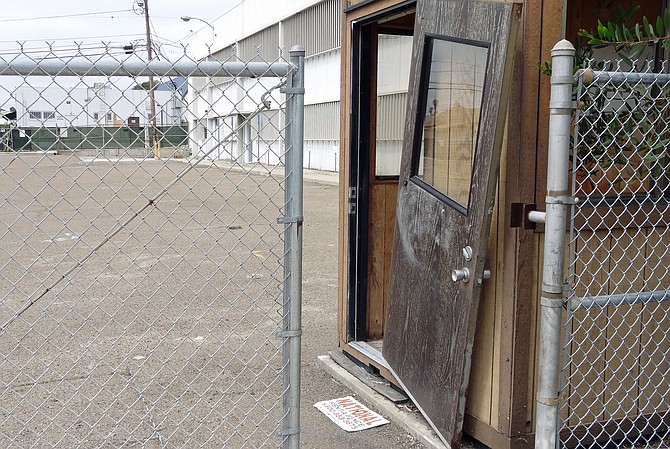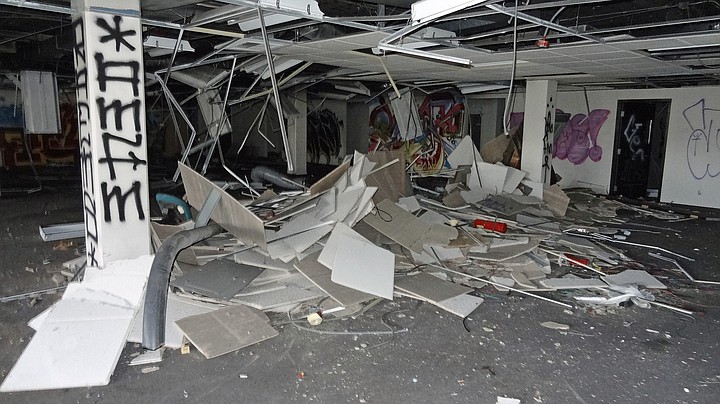 Facebook
Facebook
 X
X
 Instagram
Instagram
 TikTok
TikTok
 Youtube
Youtube

A July 5 fire at the long-vacant former AT&T building at 4220 Arizona Street (off the intersection of Texas Street and Howard Avenue) caused minor damage to the structure, which was already scheduled for demolition.
According to Lee Swanson, spokesperson for San Diego Fire-Rescue Department, “investigators determined it to be arson. Damage is estimated at $1000 to the building and $1000 to the contents.”

The building has been heavily vandalized and graffiti-tagged over the years, despite attempts by the property owners to keep out trespassers. Copper wiring/tubing and other materials have been stripped from the building.
While on a neighborhood walk on the day before the fire, I went by the property. A chainlink gate on Howard Avenue was unlocked and partially open so that anyone could enter the parking lot.
When AT&T owned the building, it was constantly tagged with exterior graffiti. More recently, the structure was breached through its back doors, and the interior was heavily trashed. Chainlink fencing was installed at the front entrance sometime back, but taggers reportedly climbed a tree to reach the roof. Extensive tagging on upper exterior walls was recently painted over by a team from Urban Corps of San Diego County.
The San Diego City Council on October 2, 2012, unanimously passed an “abatement of abandoned properties” ordinance. It makes abandoned properties (structures and empty lots) subject to the same city code sections regulating vacant properties. Both ordinances specify that empty buildings must be secured, free of graffiti, trash, and hazardous conditions, and owners must post a sign on the property with contact information.
Dave Gatzke, vice president of multifamily acquisitions at Community HousingWorks, told the Reader that his organization “is working to fortify the building from trespass and vandalism. In response to recent break-ins we were already in the process of arranging steel barriers at all doors. These will be installed later this week.” He added: “We have made arrangements to post security guards until they are installed. Roof access will also be reinforced and fortified.”
According to Community HousingWorks, about 118 market-rate apartments will be built on the site; groundbreaking is expected in early 2016. A developer has not yet been announced.
In response to previous neighborhood complaints, Gatzke said that HousingWorks “shares the community's concern about vagrants and vandalism.” Katie Keach, deputy chief of staff for District 3 councilmember Todd Gloria, declined a request for a comment from Gloria.
T-Mobile pays Community HousingWorks to have a cell tower on top of the building. An anonymous source at T-Mobile said the company will move their equipment to another location, as they don't consider it safe there now. They have to move anyway, before building demolition begins.


A July 5 fire at the long-vacant former AT&T building at 4220 Arizona Street (off the intersection of Texas Street and Howard Avenue) caused minor damage to the structure, which was already scheduled for demolition.
According to Lee Swanson, spokesperson for San Diego Fire-Rescue Department, “investigators determined it to be arson. Damage is estimated at $1000 to the building and $1000 to the contents.”

The building has been heavily vandalized and graffiti-tagged over the years, despite attempts by the property owners to keep out trespassers. Copper wiring/tubing and other materials have been stripped from the building.
While on a neighborhood walk on the day before the fire, I went by the property. A chainlink gate on Howard Avenue was unlocked and partially open so that anyone could enter the parking lot.
When AT&T owned the building, it was constantly tagged with exterior graffiti. More recently, the structure was breached through its back doors, and the interior was heavily trashed. Chainlink fencing was installed at the front entrance sometime back, but taggers reportedly climbed a tree to reach the roof. Extensive tagging on upper exterior walls was recently painted over by a team from Urban Corps of San Diego County.
The San Diego City Council on October 2, 2012, unanimously passed an “abatement of abandoned properties” ordinance. It makes abandoned properties (structures and empty lots) subject to the same city code sections regulating vacant properties. Both ordinances specify that empty buildings must be secured, free of graffiti, trash, and hazardous conditions, and owners must post a sign on the property with contact information.
Dave Gatzke, vice president of multifamily acquisitions at Community HousingWorks, told the Reader that his organization “is working to fortify the building from trespass and vandalism. In response to recent break-ins we were already in the process of arranging steel barriers at all doors. These will be installed later this week.” He added: “We have made arrangements to post security guards until they are installed. Roof access will also be reinforced and fortified.”
According to Community HousingWorks, about 118 market-rate apartments will be built on the site; groundbreaking is expected in early 2016. A developer has not yet been announced.
In response to previous neighborhood complaints, Gatzke said that HousingWorks “shares the community's concern about vagrants and vandalism.” Katie Keach, deputy chief of staff for District 3 councilmember Todd Gloria, declined a request for a comment from Gloria.
T-Mobile pays Community HousingWorks to have a cell tower on top of the building. An anonymous source at T-Mobile said the company will move their equipment to another location, as they don't consider it safe there now. They have to move anyway, before building demolition begins.
Comments